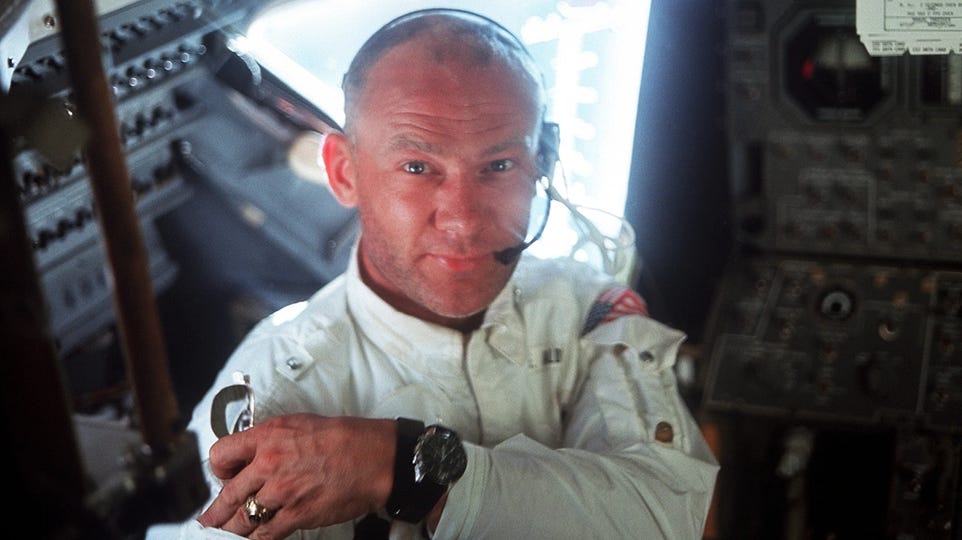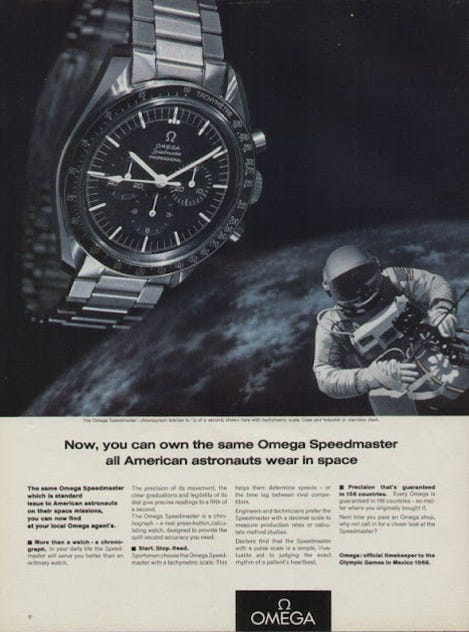The Making of an Icon: the Omega Speedmaster Moonwatch
We take a look at the story behind the Omega Speedmaster Moonwatch to learn how a watch icon is created.
“THAT’S ONE SMALL STEP FOR A MAN, ONE GIANT LEAP FOR MANKIND”. These are the words pronounced by American astronaut Neil Armstrong, after stepping on the Moon, on July 21, 1969, at 02:56 UTC. He was followed 19 minutes later by his colleague Edwin “Buzz” Aldrin who was wearing an Omega Speedmaster (see Fig. 1), while a third astronaut, Michael Collins, had remained in the Apollo 11 command module orbiting around the Moon. After 60 years from that day and countless references, the Omega Speedmaster remains one of the most iconic and recognizable chronographs in circulation.
Fig. 1: Edwin Aldrin wearing an Omega Speedmaster during the Apollo 11 mission
Courtesy of omega.com
The birth of the Moonwatch
Neil Armstrong's first step on the Moon was broadcast live on TV to a worldwide audience of more than 550 million viewers. What the viewers witnessed was also the Omega Speedmaster becoming the first watch to be worn on the Moon, when Edwin Aldrin stepped on the lunar surface. Before becoming the Moonwatch in 1969, the Omega Speedmaster was in space already twice: in 1962, worn by astronaut Walter Schirra, during the Sigma 7 mission and in 1965, worn by astronaut Ed White during his space walk, during the Gemini IV mission.
The origins of the Speedmaster Moonwatch go back to 1957 when the first Speedmaster was launched as an innovative chronograph. It was the first watch to introduce a tachymeter scale on the bezel rather than inside the dial, a trend-setting solution soon to be adopted by many other brands (see Fig. 2a).
Key milestones in the history of the Moonwatch
In 1965, NASA made the decision to adopt the Speedmaster as the official timekeeper for the Astronauts, in their future space missions. The NASA space program had started with solo-flight missions and was now entering a more important phase which included two-man (Gemini) and three-man (Apollo) missions. It was deemed necessary therefore to equip the astronauts with a timepiece that could support their extravehicular activities and endure the challenging conditions in space.
Timepieces from several brands were selected and only three brands were shortlisted (Rolex, Longines, and Omega) by NASA to go through 11 rigorous tests designed to identify the watch that had the features necessary to accompany the astronauts in space. Eventually, the Speedmaster performed better during the tests and on March 1, 1965 NASA announced the Speedmaster as the timepiece that would be part of the equipment for the astronauts.
In 1969, the Speedmaster became known as the Moonwatch, following the moon landing during the Apollo 11 mission. And in 1970, the Moonwatch played an important life-saving role during the Apollo 13 mission when an on-board explosion involving one of the oxygen tanks blew the vessel off-course. The decision was made to use thrusters from the Lunar Module to reestablish the vessel on a course to swing around the moon’s orbit and then re-enter the Earth’s atmosphere. Without use of the now-malfunctioning digital equipment, the Apollo13 crew relied upon their Omega Speedmaster chronographs to time the exact fuel burn (14 seconds) to achieve the re-entry into the Earth’s atmosphere.
In 1972, Speedmaster was one last time on the Moon on the wrist of astronaut Eugene Cernan, during the Apollo 17 mission, the last of the Apollo space program. But in 1978, the Omega Speedmaster was again confirmed by NASA to be officially part of the equipment of the astronauts who would take part in the Space Shuttle program, following a renewed series of endurance tests.
Fig. 2 - Withstanding the test of time: very little changed between the first Speedmaster version and the modern one.
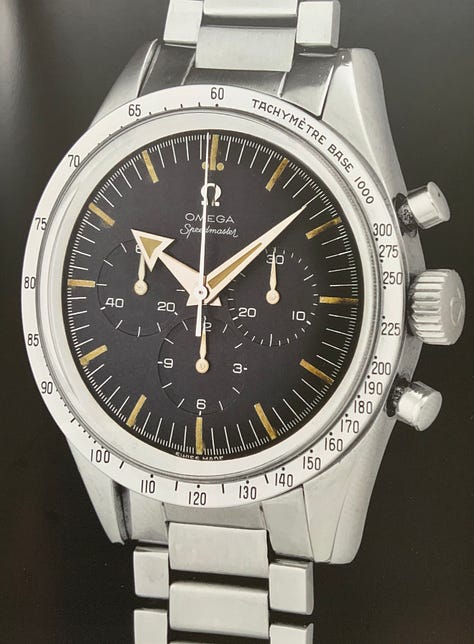
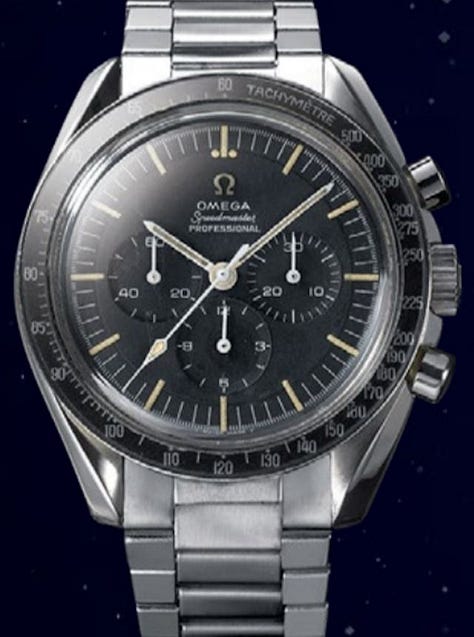
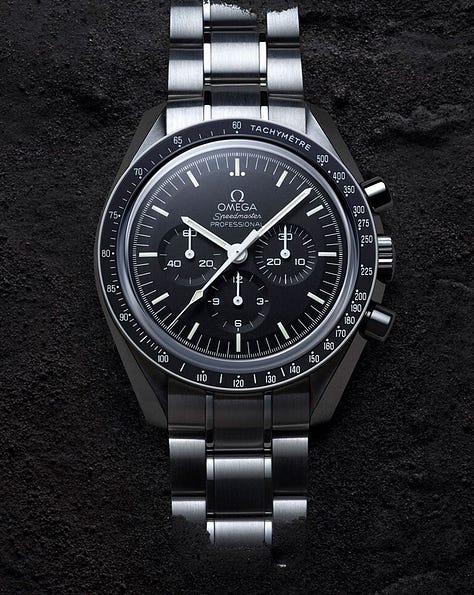
Courtesy of omega.com
What makes the Speedmaster Moonwatch an icon?
Innovation, timeless design, an enticing story, and historical significance are some of the key elements that will give a watch its iconic status, in time.
The moon landing and its historical significance have made the Speedmaster unique and given it a cult status. Very few other wristwatches can claim to have a heritage similar to the Speedmaster. Since 1969, the Speedmaster Moonwatch has undergone very little change, it has never gone out of style, and is today one of the most easily recognizable chronographs in the world.
Its design is timeless. It has a clean and well organized dial with lines and shapes arranged to deliver a sense of harmony. With the sobriety of a dark anthracite background and white hands and markers, as well as minute tracks, the dial ensures perfect legibility, even given the considerable amount of information that a chronograph function delivers. With its 42 mm case size (crown included), a height of less than 13 mm, and a lug-to-lug distance of 46 mm, the Speedmaster Moonwatch is a watch that has excellent wearability. It can be worn with style for any occasion delivering a mature presence on the wrist.
When first launched in 1957, the Speedmaster was the first chronograph exhibiting a tachymeter scale on the bezel, therefore external to the dial, where it was traditional to find it. As such, the Speedmaster was a first of its kind, a trend setter and an inspiration for many watch brands and their watches in the future.
The history of the Speedmaster spans from 1957 to the present, more than sixty years! During this time, there have been 29 references for the Speedmaster models as well as several limited editions, many of them marking missions and anniversaries, the most recent being the Apollo 11 50th anniversary edition.
Preparing for the landing on Mars
On April 12, 1961, Yuri Gagarin became the first man in space. The wristwatch that Gagarin wore during his historic space flight was made by a Soviet watchmaking company called First State Watch Company (FSWC). The watch itself bore the name of Sturmanskie, which translates into "Navigators".
Several other watches have been in space since 1961 such as Bretiling, Rolex, Paneari, and Bulova but only one made it to the Moon. The Omega Speedmaster landed 6 times on the moon. And even after the last moon landing in 1972, Omega continued to market the Speedmaster as the Moonwatch and to invest on retaining the watch’s iconic status. (see Fig. 3).
The contribution of Omega to mankind’s space exploration is destined to continue, so is the story of the Speedmaster. Omega has already created in 1998 the “Mars Watch” (Speedmaster X-33) in view of a possible landing of man on the red planet, in a not too distant future. The watch was designed in collaboration with the world’s major space agencies. At the speed at which technology is changing our way of life, it is not unreasonable to think that our progeny will need space-qualified wristwatches in their daily lives.
Fig. 3 - An Omega’s ad for the Moonwatch



